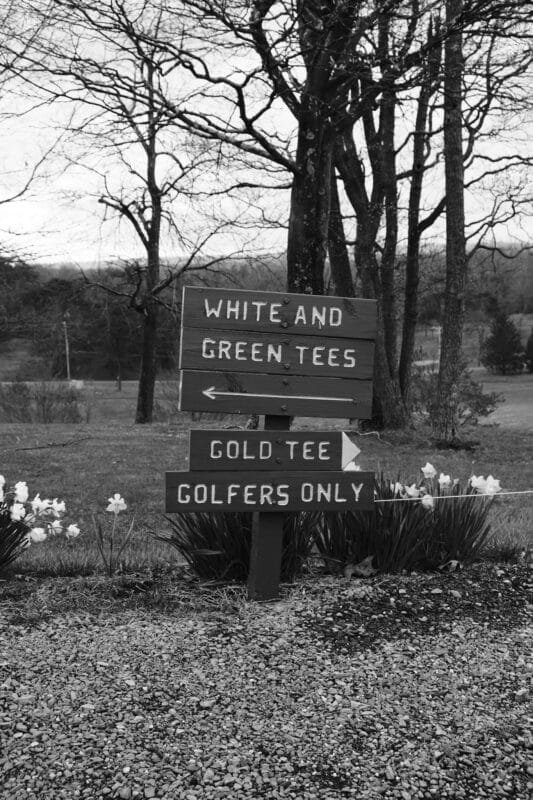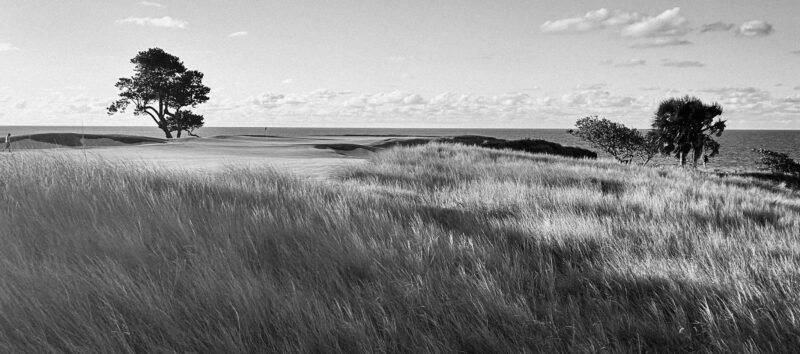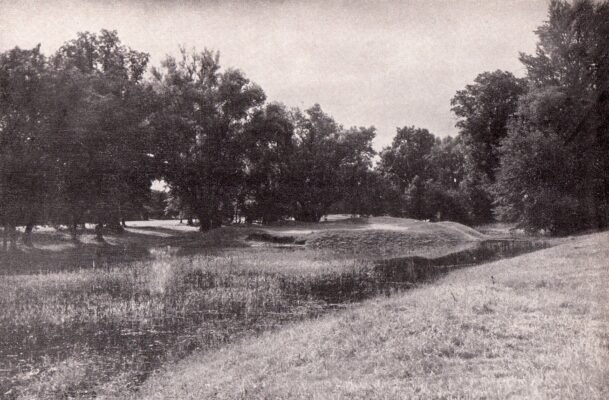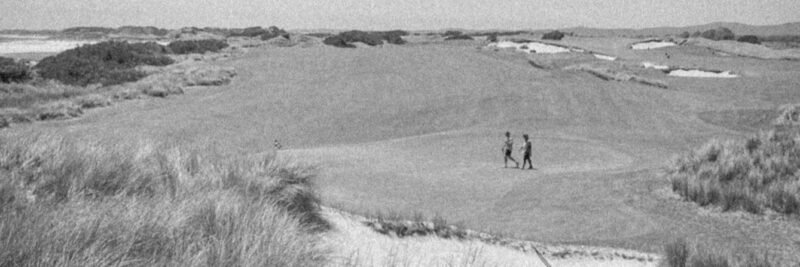An Ode to the Perfect Practice Course.
By Alex McCauley – @amccauleyart

I smack a fade pitching wedge to the right side of the first green, a shot I couldn’t have imagined when I first played here, over a decade ago. Back then, I wouldn’t have cared. My dad hits the same hard 6-iron he has since I was a kid, and ends up in a familiar place, short right. We roll to a stop after a lengthy cart coast as we get acclimated to the thick morning air. After cleaning up whatever score we got (not important), across Mountain Lookout Road we go into the Stony Lick course.
Two hundred miles southwest of my hometown near Philadelphia, down the asphalt river of Route 81, peeking into the Appalachian Mountains, is The Woods, my personal home of golf. The West Virginia resort was developed in the 1970s for people working in and around Washington, D.C., and my mother’s parents owned a small A-frame home there: Gömstället, Swedish for hideaway. It served as a getaway for their family and later, ours as well. It houses two golf courses, built in the 1980s. One full-length. One mid-length.
My grandparents had been considering selling the house for a few years, so before it officially hit the market, my immediate family took one last trip down. It had been 17 years since I was first there, before I knew what a golf club was. My mother warned us it would be difficult for her to say goodbye, so the atmosphere going into the four-day weekend was sentimental from the start.
A crumbly gravel driveway leading to the house surrounded by wise woods, with no sound but the occasional bird song or dog bark, is a setting I will never forget. And the promise of an early morning at The Woods kept my spirits high considering the memories fogging my brain. To guarantee serenity, my dad and I agreed on 8 a.m.
The Woods reminds me of the beauty of the word same. No matter how far past childhood I was, no matter the world events, the course remained constant. No better, no worse. Golf is sold as an escape from life’s challenges, but to me, golf at The Woods was an escape from the passage of time.

Arriving in the parking lot, we see the women’s club champion has been the same for nearly a decade, and we repeat the old dad-jokes about her reserved parking space sign. Laura Word will always be the name of unattainable legend to me. The soft crackling of golf spikes sprinkle my eardrums as I notice how the clubhouse buildings, still draped in their late 1980s vertical wood siding, show the time period encapsulated here. The doors, long overdue for a lubrication, open into the soft dotted carpet of the pro shop. Woody, the life-sized stuffed golfer who, I kid you not, has not moved in 15 years, still flashes his pearly cotton teeth and John Lennon glasses at me. He guards the basket of lost headcovers that inspired some of my earliest thoughts of petty theft. (Yes, I still feel guilty about my one slip-up several years ago. I was young, weak, and it was fluffy.) Even though I now outweigh him by several pounds, I bow to his soft contentment. When my dad tells the pro-shop saleswoman, who has worked there my entire life, the words “Stony Lick course,” I am reminded of all the time I’ve spent here. As far back as 2010. We’re handed our enormous cart keychain and, after I silently salute Woody, we step out into the present.
Key in. Cart on. Reverse chosen. Early morning started.
After he changes out of his Kirkland Signatures (America’s favorite Dad shoe), my dad and I head to the tee overlooking the dramatic 40-foot drop of the 175-yard first. Winter Camp Trail and Mountain Lookout Road squeeze the OB tight. Nightmarishly so even now. The green, a slanted dime. Hazard left. And firmly embedded in the backboard hill, The Woods’ logo. Young me, with no official handicap, considered this the most difficult hole in the world.
After the first hole’s challenge, I spring onto the second tee box, like a kid in a grassy candy shop. A symphony of sneaky par threes and sharp, gettable fours awaits. If you can’t hit a full swing wedge, don’t expect to score well. I’ve been lucky enough to play courses that most players have on their bucket list, but I still get starstruck every time I encounter The Woods’ property.

After the downhill, half-swing, volcano par-three second, the firmest green known to mankind, comes the first of eight par-fours. (Note: This course used to be an extremely difficult 9-holer, which my dad played during some of his fondest in-law vacations. It was reconfigured in 2002 to its current 18-hole, 3,700-yard state. Each yard as charming as the last.) The third begins the battle with the forest. It used to be driver and a full swing mid-iron for me. Even though it’s iron-wedge for me now, I cannot improve upon the scores of my past.
Golf is captivating to me in that way. No matter your skill level, you have the chance to beat anyone at any time. I cannot beat LeBron James in basketball, regardless of rim height, but it’s possible I, a D3 golfer, could score better than Scheffler on any given hole. This time, 10-year old Alex, with a par, trumped my bogey. Cruising through the deery woods gives me time to collect myself for the three narrow one-shotters approaching.
The seventh is one of the best short par fours I’ve ever played. It maxes out at 265 yards, undrivable unless you hoist a shot 75 feet up before trees 30 yards out gobble it up. Stony Lick, the course’s namesake creek, which comes into play on holes 4 through 10 and 14 through 16, gently creeps up along the right side of the rough. Inching nearer with every passing yard. With a dash of sand short right, the two-tiered green, nestled in a crop-out of wooded hills, patiently waits for my handsy flip wedge. I just know it wants to bounce my ball into the rocky woods. Throughout the years I’ve obsessively learned its defenses. Not completely sure of my score, but for sentiment’s sake, let’s say I made that birdie I was dreaming of. Faith restored, I can play golf again.

Every hole deserves its own detailed paragraph, but I easily fall into a coastline paradox with the intricacies of this course. Instead I will summarize them.
Over the next nine holes, 90 minutes, and a trip over the replica Swilcan bridge, we reflect on how Stony Lick has been present for every stage of my life, and every stage of my father’s life that includes my mom. It was often the last taste of summer my brother and I had before returning to school. My dad and I debate the ins and outs of the game while underestimating the geographical prowess of West Virginia’s emerald eye for what seems like the thousandth time. We aren’t counting shots; reminiscing dulls what’s left of our arithmetic senses.
After another downhill, half-swing, pinpoint par-three (this one includes a steep hill caution sign) our little cart transports us up to the 17th tee, where the final two holes are visible, draped on a green ribbon of bluegrass. I need to descend back to the present day. I can’t recall what my shot was on 17, probably some 9-iron. The end was too close.
Even through the closing stretch, there are no breaks, especially not the 18th. Aptly named “Shamrock” due to the shape of its green, there is no better place to harness the luck of the Irish than here. A stark contrast to the cliffside opener, it scales the opposite side of the same hill. Surrounded by a quartet of bunkers, with the clubhouse in view, par is no simple task. I muscle a wedge on. My dad lies in a bunker. Eventually we reunite by two tap-ins to finish the round.
Pin in. Hats off. Hands shaken. Last looks taken.
While retreating back to the buggy and, subsequently, our real lives, my dad suggests we take a page from Shota Hayafuji, Hideki Matsuyama’s caddie, and bow. Placing my belongings on the cart shelf, we amble to the lookout.
Silently, we give Stony Lick its well-deserved flowers.

Alex’ first season at The Woods as a junior.
Alex McCauley is currently studying Economics and Statistics at Muhlenberg College where he is also co-captain of the Men’s Golf Team. He tends to practice shot-shaping and 3-wood shots on the range instead of other skills he needs to focus on. His photography work (@amccauleyart on Instagram) consists of calmly composed black-and-white images with a strong focus on lines and shadows. Speaking both Swedish and English he has been lucky enough to see golf evolve in two vastly different cultures.




